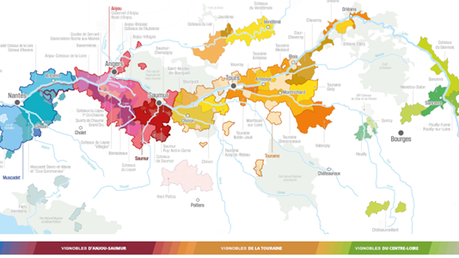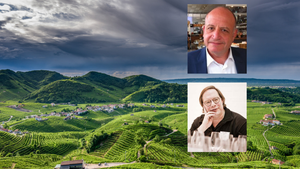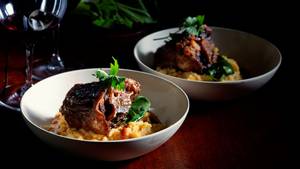The Loire Valley is home to 5 winegrowing regions spread over 14 departments and is home to 53 AOP and Loire Valley IGP. This article takes you on a tour through the Loire, exploring some of the subregions’ individual characters and similarities in the process.
Muscadet Sèvre et Maine: Where the Atlantic and the Loire Meet
Muscadet Sèvre et Maine is an appellation within the broader Muscadet AOC in the western Loire Valley of France. Here where the Loire Valley opens to the Atlantic Ocean white wines, made from the Melon de Bourgogne grape, display their cool-climate character with notable acidity, freshness and salinity merged into a wine style known for its affinity to pair with seafood and produce of the region.
The terroir is characterized by three distinct types of soil: gneiss, a metamorphic rock; mica schist, a flaky, crystalline rock; and amphibolite, a dark, igneous rock. These soils impart the wines with a mineral-driven complexity that is emblematic of the region. However, the terroir is more than simply a result of soil. The cool, maritime climate of this part of the Loire Valley ensures a slow ripening process for the grapes, allowing them to produce wines with distinctive acidity, freshness and zest.
Muscadet Sèvre et Maine wines must also undergo a process known as "sur lie" aging, where the finished wine is left in contact with the dead yeast cells, or lees, for several months. This results in wines with added depth, texture, and a slight yeasty, bread-like quality. It is this combination of unique terroir, varietal character, and winemaking technique which makes the wines of Muscadet de Sèvre et Maine so distinctive and why they are known throughout the world.
COTEAUX DU LAYON AND SAVENNIERES: One Grape, Two Personalities
Coteaux du Layon and Savennières are two distinct wine regions, both renowned for their exceptional white wines. While both regions share similarities in terms of geographical location and focus on producing high-quality wines based on Chenin Blanc, they offer polar extremes flavours that differ in terms of grape varieties, wine styles, and terroir
Coteaux du Layon is famous for its luscious, sweet wines made from Chenin Blanc. The appellation benefits from a microclimate conducive, thanks to the convergence of the Layon River, and the misty weather this creates, to the development of botrytis cinerea, or noble rot. The botrytis concentrates the grape sugars, and acids in the Chenin Blanc grapes of the region, imparting unique flavours and aromas. The resulting wines are rich, honeyed, and often exhibit notes of apricot, pineapple, and honey.
On the other hand, Savennières is known for its dry, sometimes described as ‘bone dry’ and age-worthy white wines, which are also crafted from Chenin Blanc grapes. Savennières, in contrast to Coteaux du Layon has a cooler climate, with the vineyards situated on steep slopes composed of schist and sandstone. This terroir imparts a distinctive mineral character to go along with vibrant acidity, green apple, and quince flavours the wines are known for. These wines are often aged in oak barrels, which adds further depth and structure to the final product. While Savennières can be enjoyed in their youth that also have the potential, like Coteaux du Layon, for extended aging.
Saumur and Saumur-Champigny: Limestone Lovers
On the south side of the Loire, lie the Saumur appellations, with Saumur-Champigny nestled within Saumur. Here, bedrock of limestone - tuffeau - is predominant, giving rise to exceptional Cabernet Franc and Chenin Blanc wines.
Saumur-Champigny, historically known for producing lighter, fruitier wines, has seen an evolution in its wine style in recent years, with more exacting and high-caliber reds emerging. Yet the legacy of its light, fruity style may still be present, which helps distinguish it from its Touraine neighbors.
Vouvray: The Tale of the Right Bank
Vouvray adorns the right bank of the Loire. The region is characterized by tuffeau, a local type of porous limestone that provides excellent drainage, perfect for viticulture. Vouvray, sculpted by the Loire over millennia, present itself as grand amphitheaters of vineyards lined with sheer cliffs and steep slopes. These rocky outcrops have lent themselves to the creation of wineries, caves, and residences.
However, the topsoil above the tuffeau base becomes the defining point of distinction. The primary topsoil families are perruches, a clay-flint mix creating tense wines with a hint of citrus and white flowers, and aubuis, a yellowish clay-limestone-flint blend known for producing denser, more powerful wines.
Furthermore, the depth of the soil before the vine roots reaches the tuffeau plays a role in the wine's character. Wines from vineyards with deeper, heavier clay layers are fruitful and round. Consequently, Vouvray, with clay and aubuis, is famous for its weight.
Vouvray is often voluptuous and minerally strong, with flavors ranging from peaches to quince. The power of Chenin Blanc in its wine will captivate your senses.
Chinon: Layers of a Loire Hillside
Moving westward, we arrive at Chinon, which almost mirrors Vouvray in soil composition and terrain. The three main soils – sand, gravel, and clay-limestone – make up different layers of the hillside, each contributing a distinct personality to the wines produced.
The wines from the base of these hills, where sand and gravels dominate, are lighter and easier to drink. As we ascend, the soil takes on more gravels and pebbles with a clay subsoil, producing deeper wines with more tannin and concentration. Moving further up, the clay and limestone lead to finely textured, long wines.
Chinon, shielded slightly by a narrower river valley, produces supple, fruit-forward wines, that can be enjoyed young.
Vouvray: The Tale of the Right Bank
Vouvray adorns the right bank of the Loire. The region is characterized by tuffeau, a local type of porous limestone that provides excellent drainage, perfect for viticulture. Vouvray, sculpted by the Loire over millennia, present itself as grand amphitheaters of vineyards lined with sheer cliffs and steep slopes. These rocky outcrops have lent themselves to the creation of wineries, caves, and residences.
However, the topsoil above the tuffeau base becomes the defining point of distinction. The primary topsoil families are perruches, a clay-flint mix creating tense wines with a hint of citrus and white flowers, and aubuis, a yellowish clay-limestone-flint blend known for producing denser, more powerful wines.
Furthermore, the depth of the soil before the vine roots reaches the tuffeau plays a role in the wine's character. Wines from vineyards with deeper, heavier clay layers are generally more fruitful and round. Consequently, Vouvray, with clay and aubuis, is famous for its weight.
Vouvray is often voluptuous and minerally strong, with flavors ranging from peaches to quince. The power of Chenin Blanc in its wine will captivate your senses.
Chinon: Layers of a Loire Hillside
Moving westward, we arrive at Chinon, which almost mirrors Vouvray in soil composition and terrain. The three main soils – sand, gravel, and clay-limestone – make up different layers of the hillside, each contributing a distinct personality to the wines produced.
The wines from the base of these hills, where sand and gravels dominate, are lighter and easier to drink. As we ascend, the soil takes on more gravels and pebbles with a clay subsoil, producing deeper wines with more tannin and concentration. Moving further up, the clay and limestone lead to finely textured, long wines.
Chinon, shielded slightly by a narrower river valley, produces supple, fruit-forward wines, that can be enjoyed young.














